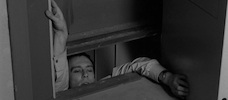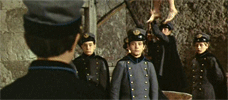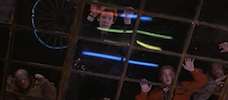Reviews
Louis Malle
France, 1965
Credits
Review by Rumsey Taylor
Posted on 21 August 2009
Source MGM DVD
Categories Women of the West
Malle Entendu: The Ecstatic, Eclectic Cinema of Louis MalleViva Maria! is found early in Louis Malle’s esteemed career, following his debut, Elevator to the Gallows, by seven years, preceding his later, coming-of-age films Murmur of the Heart, Lacombe, Luçien, Au revoir les enfants, and solidifying none of the aesthetic or tonal consistencies in any of these films. It is a marvelous anomaly—a Western, a musical, a screwball comedy, an action movie. The visual gags are so constant and inventive that you pause in realization that this film is helmed by the same person who made perhaps cinema’s sole heartfelt movie about incest.
The film is anchored by French New Wave masthead stars Bridgette Bardot and Jeanne Moreau, and it is this pairing alone that enables Viva Maria! as a permanent cinematic novelty. The pair are partners in a traveling vaudeville routine—both are named Maria: Moreau the brunette, shyer one, and Bardot the more lackadaisical. They’re in the middle of Central America in the early 1900s, and hostility is all around them. As their troupe caravans from one oppressed village to another, they become responsibly sympathetic to the populace that attends their performances.
These performances, in particular, are not only outstanding—a striptease that finds the pair in identical outfits, cast off in increasingly daring methods—but shot in a cinematerpsichorean fashion unbecoming in Malle’s typically nuanced direction. The musical numbers encourage elaborate montages that summarize the development of the girls’ adventures, and even when there’s no singing or music, the spirit remains firmly playful. The subsequent battle scenes are effectively no different from the musical numbers in their elaborateness.
As the girls’ routine becomes more famous, they become a sort of icon of revolution because they’re capable of absorbing and directing attention (once they ensure a dying soldier that they will endorse and support his cause in the revolution). This is precisely what happens, of course, only the ensuing revolts are attended not only by the women, but their carnival crew, resulting in battles that have the same invention and comedy of a Baron Munchausen adventure. There’s a quintuplet of acrobats, for example, who’ll hoist their brothers into second-story windows, or a woman who’s prone to smacking people, tempering them with precisely the same action intent to discipline her perpetually misbehaving son. This all culminates in a pair of spectacular set pieces, the first of which exhibits Bardot single-handedly infiltrating an enemy fort with a bomb in a Rube Goldberg display of circumstantial acrobatics, and in the middle of a mountainous valley.
The level of comedy and adventure is consistent and maximized, at the expense of the tone of oppression that strews the vaudeville performances to the Central American setting and, in turn, the elaborate battle scenes. This is, at times, asynchronous; Viva Maria! is ballasting sympathy with ridiculousness. But the same disparity in tone describes other Malle films, Laçombe, Lucien in particular, in which the title character, a young boy in the German occupation of France, remains lackadaisical in the middle of the war. In this instance, it’s Lucien’s naïveté that’s the most compelling aspect of the story. If Viva Maria! concentrated expressly on the background conflict, it would have been far less satisfying than it is, and it is no flaw that its ridiculousness—the increasingly revealing stripteases, the circus performer army, Bridgette Bardot with a Gatling gun—compromises its ethical responsibilities in telling this particular story.
More Malle Entendu: The Ecstatic, Eclectic Cinema of Louis Malle
-

Viva Maria!
1965 -

Elevator to the Gallows
1957 -

Zazie dans le métro
1960 -

William Wilson
1968 -

Black Moon
1975 -

Lacombe, Lucien
1974 -

Atlantic City
1980 -

My Dinner with Andre
1981 -

Crackers
1984 -

God’s Country
1985 -

Vanya on 42nd Street
1994
We don’t do comments anymore, but you may contact us here or find us on Twitter or Facebook.



